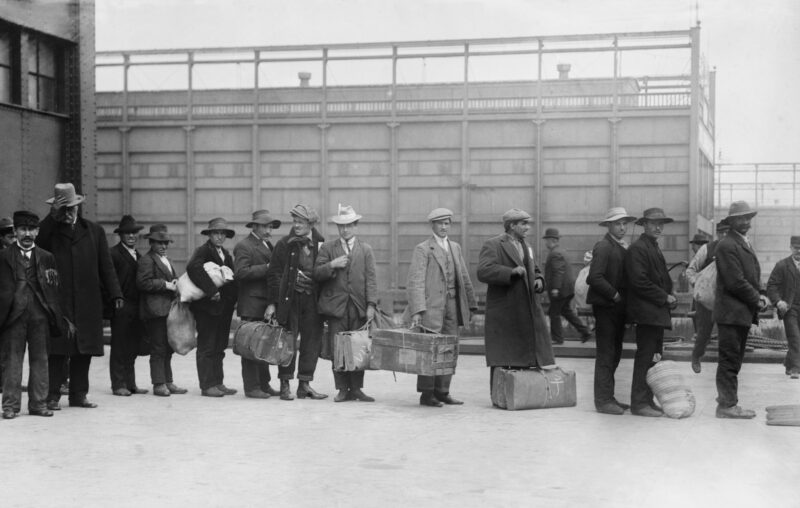Is America Today Less Able Than In the Past to Economically “Absorb” Immigrants?

Everyone knows that, because for most of her history, America had almost no restrictions on immigration, America is overwhelmingly a nation of descendants of immigrants. In this case, everyone is correct. Everyone also knows that following a few rough years at the start, America’s economy and population, have since the 1607 settlement of Jamestown, grown impressively and pretty steadily. In this knowledge, too, everyone is correct.
Here’s something else that everyone knows: While a regime of no immigration quotas was a boon to America’s economy in the past, eliminating now the immigration quotas that have been in place since the 1920s would wreak havoc on America’s economy. In this knowledge, however, I believe that what everyone knows is incorrect.
Whenever I discuss immigration policy with my students or with general audiences, I often ask this question: “Because America’s economy enjoyed unprecedented economic success during her first 300 years when there were almost no restrictions on immigration, what, if any, reason is there to think that eliminating immigration quotas today would harm America’s economy going forward?”
Three different answers are offered. One answer – the least frequent of the three – is that the people who would immigrate to America today if the government eliminated quotas differ fundamentally from the kinds of people who poured into America during her first 300 years. This answer is easily dismissed. Irish immigrants in the 19th century were widely regarded by native-born Americans as lazy drunkards who were hopelessly inferior in intellect and character to the stock of Europeans who earlier immigrated to North America. Immigrants coming a bit later from Italy, Eastern Europe, and China were held in similar contempt. The contempt with which some native-born Americans today hold the people whom they fear would immigrate to the US under a more liberal regime differs not one iota from the contempt with which these same Americans’ immigrant ancestors were held by earlier generations of native-born Americans.
The second answer is that America had no welfare state until well into the 20th century. The existence of a welfare state, it is claimed, means that eliminating immigration quotas would no longer work to America’s economic advantage. The worry is that too many immigrants would come not to work, but to free-ride on American taxpayers. In a later column I’ll explain why I believe this worry to be an unpersuasive reason to oppose the elimination of immigration quotas.
The third answer is that even if there were no welfare state, the American economy today – unlike in the past – can no longer economically “absorb” many immigrants. The notion is that America is now crowded, with too little space, scarcer resources, and too few economic opportunities to accommodate relatively large numbers of immigrants.
While on its face this claim appears strong, this claim weakens greatly upon inspection.
Consider the first Americans’ purchasing power – our access to goods and services. In inflation-adjusted dollars, per-capita GDP in the US in 2023 is more than eight times higher than it was in 1920, the last census year before immigration quotas were imposed. Americans’ ability today to afford (which isn’t to say willingness to pay) to deal with whatever problems might be created or exacerbated by influxes of immigrants is multiple times what it was a century ago.
Now let’s look at some specifics.
The population of the US in 1920 was 106 million. Today the country’s population is nearly 340 million – an increase of 221 percent. Although since 1920 the US added Alaska and Hawaii as states, the resulting increase in the nation’s landmass was only about 20 percent. Yet despite America’s growing population, among the nations of the world the US today ranks 148 out of 199 in population density. With only 91 people per square mile, America is far less densely populated than are, for example, Denmark (360 persons per square mile), Germany (600/sq. mi.), the UK (720/sq. mi.), Japan (840/sq. mi.), the Netherlands (1,100/sq. mi.), and Taiwan (1,750/sq. mi.) – rich countries all. Geographic-space-wise, the US isn’t close to being crowded.
But because ours is no longer an agricultural economy, and because most people apparently prefer to live in densely populated cities and suburbs, population density per-square mile of geographic space is less significant than it at first appears. A more relevant statistic is residential living space. Here too, our ability to “absorb” immigrants is much higher than in 1920. In 1920 the amount of residential floor space per person in the US was 242 square feet; today (2014) each American has, on average, 1,046 square feet – more than four times as much as a century ago.
What about food? Crop yields today are much higher than in 1920. For example, wheat yields have tripled and corn yields have quintupled. This increase in agricultural productivity has reduced the real price of food. In turn, the percentage of Americans’ total personal income spent on food has fallen dramatically.
Let’s look at some other goods and services that might be relevant for assessing America’s current ability to “absorb” immigrants compared to its ability to “absorb” immigrants just before quotas were imposed.
- Petroleum In 1920 America had 7.5 billion barrels of proved reserves; today (2023) America has 68.8 billion barrels. On a per-capita basis, for every American in 1920 there were 71 barrels of proved petroleum reserves, while in 2023 the number of proved reserves per American is 202.
- Teachers in primary and secondary schools In 1920 America had 1 teacher for every 32 pupils; today America has 1 teacher for approximately every 15.5 students.
- Physicians In 1920 the number of physicians practicing in America was 144,977, or one physician for every 731 Americans. The number of physicians practicing in America today is 1,077,115, or one physician for every 316 Americans.
- Dentists. In 1920 the number of dentists practicing in America was 52,152, or one dentist for every 1,888 Americans. The number of dentists practicing in America today is 202,536, or one dentist for every 1,679 Americans.
- Police officers In 1920 there were 82,120 police officers in the US, or one police officer for every 1,291 Americans. Today (2021) there are 660,288 police officers in the US, or one police officer for every 515 Americans.
- Firefighters In 1920 there were 50,771 firefighters in the US, or one firefighter for every 2,088 Americans. Today (2020) there are 1,041,200 firefighters in the US, or one firefighter for every 327 Americans.
- Capital per worker Perhaps most importantly for those people who worry about America’s ability to “absorb” immigrants is capital per worker. The reason is that real wages are determined by worker productivity, and worker productivity is chiefly determined by the amount of capital workers work with. I can find no good data for 1920, but in 1950 America’s total stock of (non-human) capital was (in 2017 dollars) $10.6 trillion and the size of the labor force was 62.2 million. The amount of capital per worker was then, on average, $169,806. (It was surely lower in 1920.) Today (2019) America’s total stock of (non-human) capital (in 2017 dollars) is $69.1 trillion and the size of the labor force is 167.8 million. The amount of capital per worker is today, on average, $411,460. On average, the American worker today works with 142 percent more capital than did his or her counterpart in 1950.
This estimate – and here I speculate – of the growth of capital per worker is almost certainly low, enormously so. Not only does it exclude human capital, it likely undercounts improvements in the quality of capital goods. Strong evidence that this estimate of the growth of capital per worker is too low is that, in 2023 dollars, the average hourly manufacturing wage in the US in 1920 was $8.27; today this wage is $32.61 (not counting fringe benefits). This substantial real-wage growth suggests that over the past century the amount of capital per manufacturing worker at least quadrupled. Because real per-capita income in the US today is more than eight times its level of a century ago, it’s likely that the amount of capital per worker in the service sector (where most Americans work) has much more than quadrupled.
The above measures are only samples, but they are of economic factors especially relevant to the question of a country’s ability to “absorb” more inhabitants. These measures cast grave doubt on the assertion that America’s ability to “absorb” immigrants is today less than it was in the past. Quite the opposite seems to be the case.










